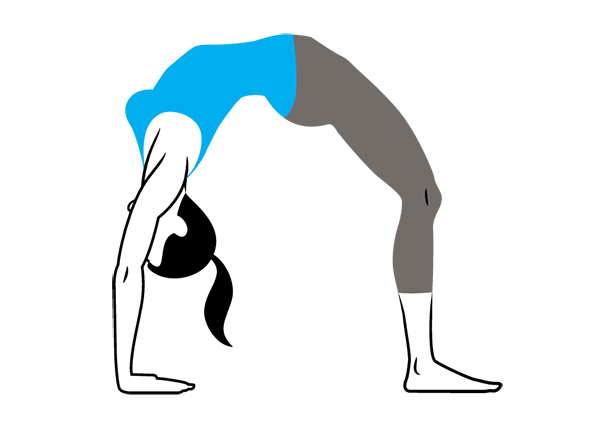
[ad_1]
QUESTION:
Some academics inform college students to not “squeeze” or “grip” their gluteal muscle mass (or glutes) in backbends as a result of this can compress the sacrum and decrease again. Others say that it’s important to make use of the glutes in backbends. What do you suggest?
ANSWER:
First, let’s acknowledge that completely different college students might profit from barely completely different actions in any given posture. So, probably the most correct method to reply this query is to say that the majority college students will profit from participating their glutes in backbends. Right here’s why:
GLUTES IN BACKBENDS: THE ESSENTIAL ANATOMY
The gluteal household consists of the gluteus maximus, gluteus medius, and gluteus minimus. When academics speak about participating the glutes in backbends, they’re referring to the gluteus maximus. Once we interact the gluteus maximus—notably the decrease fibers close to the hamstring insertion—these muscle mass prolong the hip-joint. This can be a good factor as a result of we would like the hips to increase barely once we do backbends in an effort to assist decompress the lumbar backbone. Gluteal engagement additionally helps stabilize the sacroiliac joint—which is effective as a result of so many long-time yogis have hypermobile and unstable SI joints.
However, let’s reply the query with just a little extra nuance since some backbends are enhanced by gluteal engagement and others usually are not. Susceptible backbends like Locust and Cobra Pose in all probability don’t profit as a lot from gluteal contraction as a result of the load of the pelvis rests on the ground throughout these postures. Which means you don’t want gluteal energy to raise the pelvis as a result of it stays on the bottom within the pose; you additionally don’t want the stabilization that the glutes present as a result of the pelvis is supported by the ground.
In kneeling backbends like Camel Pose and supine backbends like Bridge Pose and Upward Going through Bow Pose, gluteal engagement is extra useful. These postures produce a better diploma of spinal extension so it’s much more necessary that the pelvis and backbone transfer cohesively. Partaking the glutes close to the hamstring insertion, will assist preserve this stability by rotating the pelvis barely again excessive of the legs. This can assist scale back lumbar compression—the sensation of your lower-back “crunching.” Much more, the glutes assist raise the load of the pelvis in supine backbends. Should you don’t use the glutes in these postures, you may unnecessarily burden much less environment friendly muscle teams.
Some academics and college students are involved that utilizing the glutes will make the knees splay too far aside. This can be a respectable concern, but it surely’s simply managed. All you need to do on this scenario is co-contract the muscle mass that line the within of your thighs, the adductors. Firing the adductors when you interact your glutes will maintain your thighs good and impartial.
THE SEQUENCE
Within the poses that comply with, the inclined (face-down) backbends are instructed with passive glutes, whereas the kneeling and reclined backbends are instructed with energetic glutes. I encourage you to experiment in these postures and observe what works greatest in your physique.
Locust Pose
Lie down in your stomach. As you exhale, raise your upper-body away from the ground. Root down by way of the highest of your ft and floor the highest of your smallest toe. Hold the glutes passive and give attention to the work of your spinal muscle mass.
Cobra Pose
Once more, begin in your stomach. Place your fingers on the ground on both aspect of chest. Press down by way of the tops of your ft and your pubic bone as you partially straighten your arms. Draw your shoulder blades down your again and hug your elbows towards your sides. Hold your glutes passive and permit your spinal muscle mass and arms to information you into the posture.
Upward-Going through Canine Pose
Come into Upward-Going through Canine from Chaturanga. When you’re in Updog, enable the glutes to be comparatively passive. Concentrate on grounding down by way of your fingers, fingers, and ft whereas lifting your thighs, hip-points, and chest.
Bridge Pose
Lie in your again, bend knees and place your ft flat on the ground, near your hips. Separate your ft hip-width. You’ll be able to both maintain your arms by your sides or clasp your fingers beneath your buttocks. Press down by way of your ft and lift your hips. Your glutes will hearth to assist increase your hips. Gently interact your inside legs by imagining that you simply’re squeezing a block between your thighs.
Camel Pose
Kneel in your mat and contact your hip-points together with your finger suggestions. When you have a block, place it between your inside thighs. Carry your hip factors up and lengthen your tailbone down. This motion will start to fireplace your glutes close to the insertion of the hamstrings. (One among my academics, Richard Rosen, calls this a part of the glutes the LBMs, or decrease buttocks muscle mass.)
Take your fingers to your heels, raise your chest, and lengthen your breath. If there’s a block between your thighs, squeeze it firmly. This engages your adductors and retains your thighs parallel to one another.
Upward Bow Pose
Lie in your again such as you did for Bridge Pose. Separate your ft hip-width. Carry into the posture in your exhalation. As soon as you’re within the posture, deliver your consciousness to your glutes. Given the demand of the posture, your glutes shall be firing. Really feel the assist that they’re offering whereas being conscious to concurrently interact your inside thighs by hugging them towards your midline.
{illustrations by MCKIBILLO}
[ad_2]